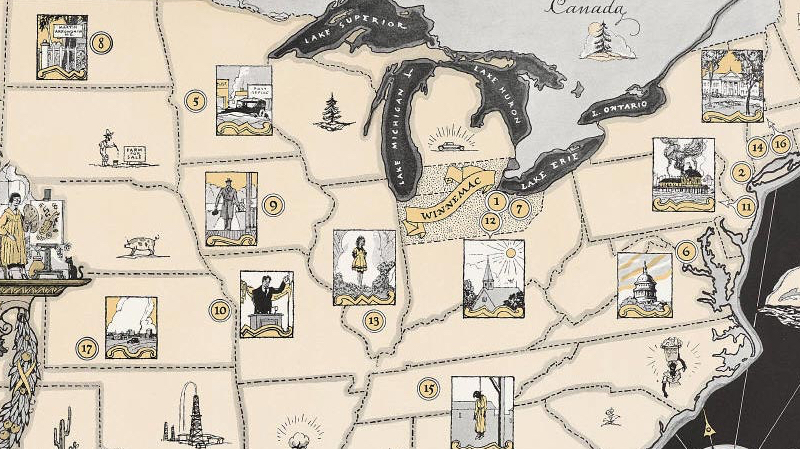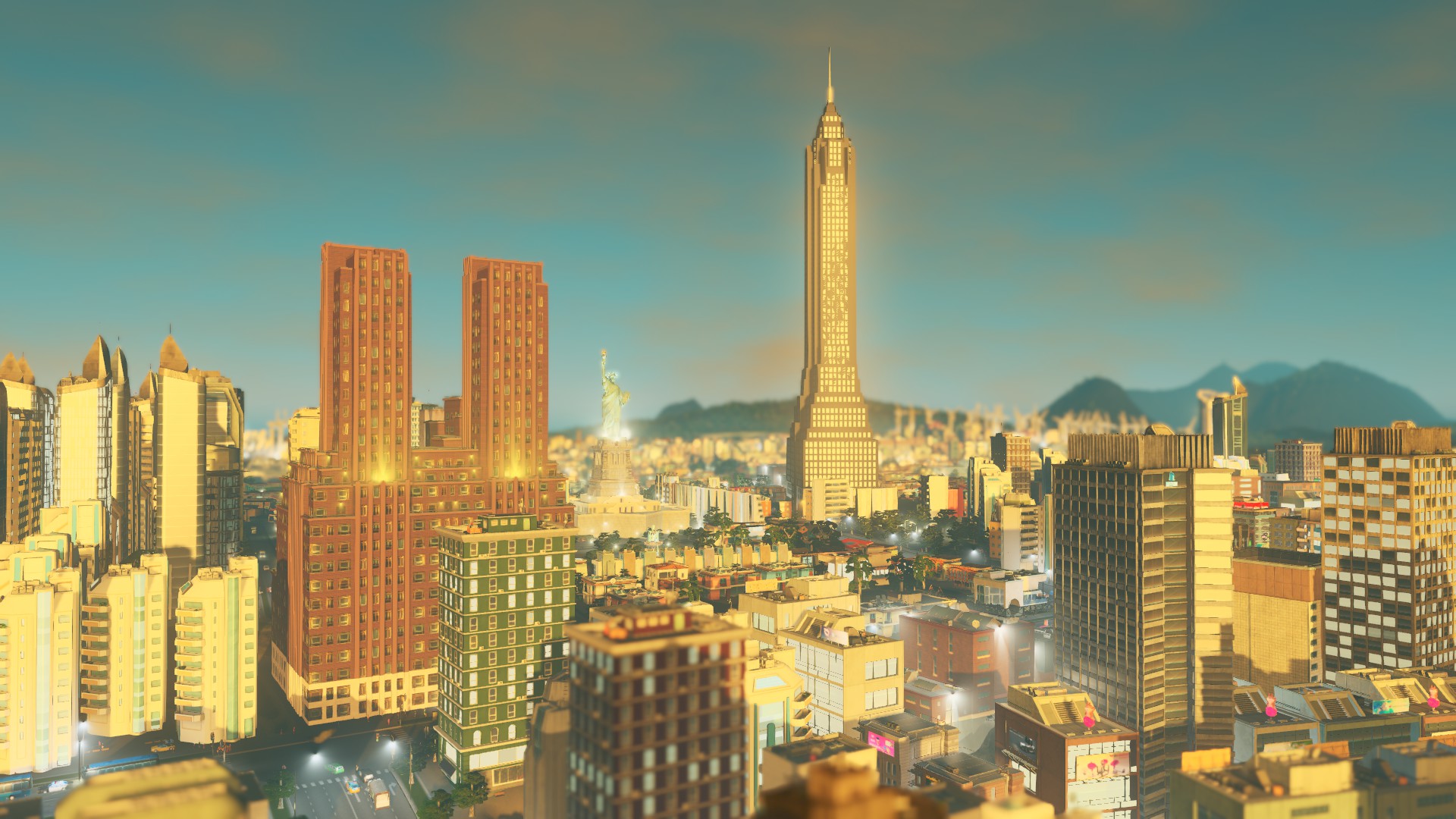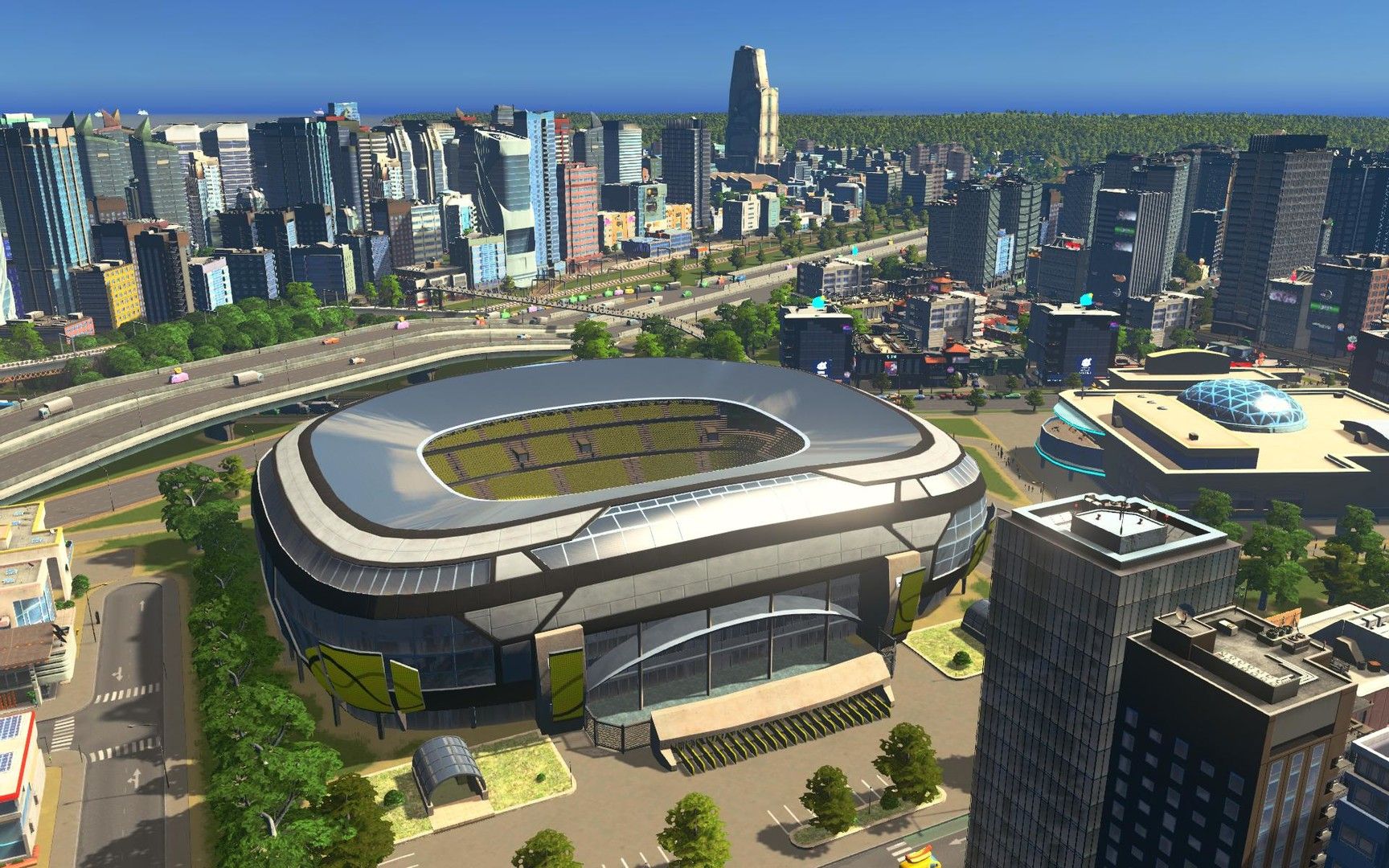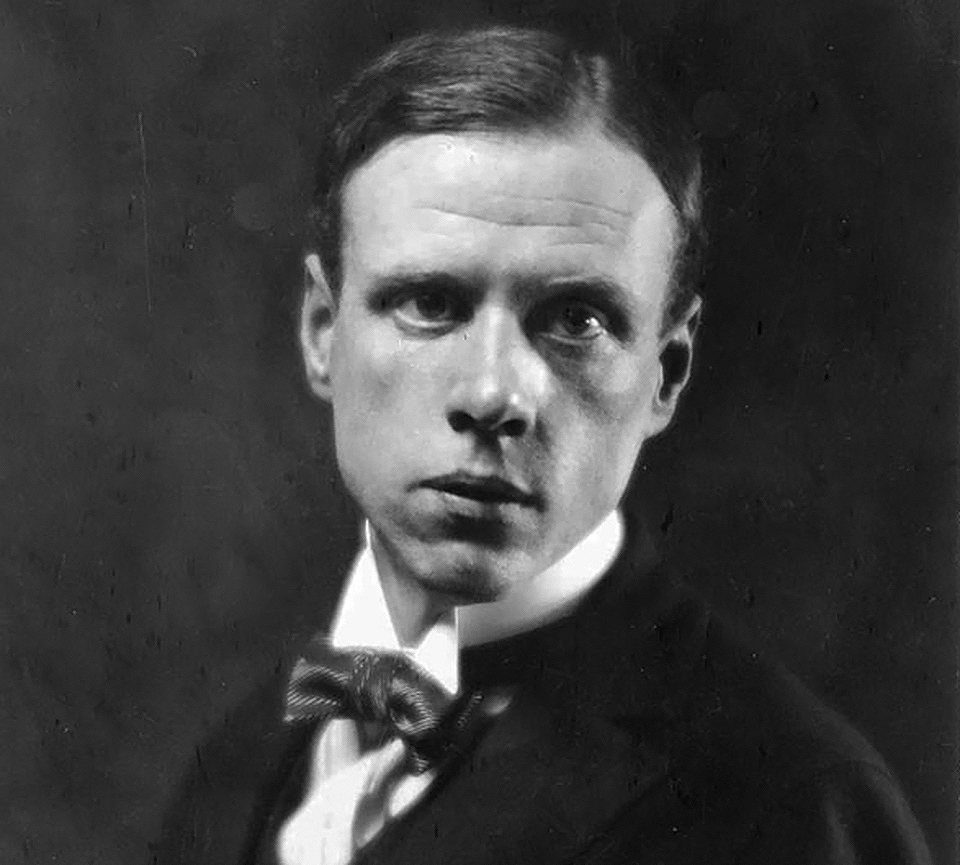Announcing “Tales from Winnemac: A Cities: Skylines Storytelling Project.”
The official announcement of the next big hyperfiction artistic project in my life: a series of ultra-realistic and complex Cities: Skylines game builds, released under a Creative Commons license, for others to set stories and videos about the American Midwest's 300-year history
#arts #artistic #literary #crossgenre #crosstech #hyperfiction #roleplaying #storytelling #videogame #gaming #citiesskylines #paradoxinteractive #citybuilding #sim #simcity #complex #althistory #sinclairlewis #winnemac #america #us #midwest #suburbs #creativecommons #open #openarts #openletters #opensource

At least since the 1990s (and probably something that could be tracked all the way back to my college days in the '80s), I've had a strong interest in exploring storytelling through exploring a specific space, and examining how that space influences the stories being told through it. That's why I'm so enamored with Kurt Busiek's “Astro City” comics series, for example, or Scott Snyder's run on the rebooted 21st-century Batman, because they exactly explore this sense of place and what kind of influence this place has on the stories that are told through it. I fiddled around back then in the '90s with a giant make-believe map in the old page layout program Quark XPress, imagining a fictional city with all these quirky corners and deep history, but the technology for actually building the city out beyond just a theoretical place I was describing in my writing was lacking at best. That is, until the rise of the video game Cities: Skylines (CS), which I accidentally became obsessed with at YouTube during the pandemic, after accidentally discovering through algorithm the channel of an actual governmental city planner who plays the game using the actual real theories of actual city planning. I was impressed that the game was sophisticated enough to enact these complex, multilayered plans that meld architecture, sociology, traffic management and culture; and as I looked more into it, I discovered that the game is essentially like the old urban planning game SimCity, which my friends and I used to trade via illicit floppy disks back in college at the turn of the 1990s in the middle of our cyberpunk years, but now all blown up and tricked out for a gaming-computer age.

Of course, that means you need a souped-up gaming computer to play CS, which was an issue for me because, other than a run of Minecraft with my friend Carrie's sons in the 2010s, I hadn't played video games regularly since way back in my original early-'90s SimCity days, and have never particularly been a console fan during that entire time either. So I waited and waited, and put my money together more and more towards buying one of these ridiculously expensive gaming computers, and began obsessively following other CS YouTube channels and learning more and more about how to play; and finally in spring 2022, I was able to buy an Acer Nitro 5 on Amazon Prime Day for under a thousand dollars, which at the time I got it was way capable of all the needs of a relatively tame video game like CS. And then slowly over that spring and into summer, I eventually bought CS, and then the couple of hundred dollars of downloadable content (DLC) packs that have been created for it since its 2015 creation, then took all the advice I could find from these CS YouTube channels about what mods I should install to get the best experience out of the game as possible. That's the downside of a game that gives you such fine-tuned control over each and every detail of your made-up metropolitan area; there's a lot to learn as well, and a lot to buy, a lot of time spent on the shared online library of assets that other passionate players have created in software like Blender for the betterment of the entire gaming community.

A few weeks in, and I'm finally starting to get to a place where I'm ready to throw myself into my first scenario, so I wanted to get an introductory essay up that explains the larger fictional scenario behind all my first cities I'll be building. To be specific, I'm adopting the concept of “Winnemac,” the fictional Midwestern US state that Sinclair Lewis invented in the 1920s as a place to set all the biggest hits of his career, including Babbitt, Arrowsmith, Elmer Gantry, Dodsworth and more. As you can see in the illustration above, it's supposed to occupy the northern part of real-life Indiana, the southern part of Michigan, and the northwest part of Ohio; so like all these neighboring states, it's made up mostly of farmland, punctuated here and there by mid-sized collegetowns and a small dotting of cities that blew up during the Industrial Age into major metropolises. I thought this would be a great option in which to set my CS city storytelling projects as well, because it will let me tell all the kinds of stories I want (at least for the moment), especially since so many of them will be based on the places I've lived in from this same area of the country, from big-city Chicago to suburban St. Louis, the Missouri collegetown of Columbia, and more.
I have to admit, I'm feeling kind of intimidated by the entire thing here at the beginning, so I'm starting with a nice easy project and am going to try to build one of the smallish towns you see all over the place here in the Midwest, which was actually inspired this last week while passing the Illinois town of Pontiac during my Amtrak trip from Chicago to St. Louis. Named “Horizon” in my case, like many of them in the real world, mine got its start in the mid-1800s because of the rise of the railroad through this region, which provided a central location for the scattered farmers in the area to gather regularly and get their goods sold and shipped much faster than ever. That led to a 1800s grid-style central city surrounding the train station in the middle, with a traditional public square facing it where the governmental buildings were located, the surrounding farms connected in through the ancient Native American horse trails in the area, eventually adopted by frontiersmen and then settlers in the 1700s and early 1800s, eventually becoming the paved highways of the area during the automobile age. This will give me a nice basic scenario to build a nice basic first city in CS, and make all kinds of mistakes and be able to bulldoze and start over, just sort of a level-one playground to get used to the interface and what options I now do and do not have because of all these DLCs and mods.

In my roleplaying scenario, Horizon has continued to do pretty well for itself over the decades, unlike a lot of these Midwestern small towns that sort of crumpled after the implosion of whatever nearby industry had been financing all the residents; so while it still has its central grid infrastructure, there's been a series of more modern subdivision-style residential neighborhoods and strip malls built in the decades since, and sections of the old downtown transformed into modern amenities such as a tech startup incubator, a farmer's market and more. I'm also roleplaying the idea that Winnemac's second-largest city, Progress (but more on them in a bit), eventually wins an Olympics bid, but only on the promise of building out brand-new specific sports complexes around the surrounding areas turned into public use after the games; so in Horizon's case, I'm going to be building an entire tennis complex in the style of the Billie Jean King National Tennis Center in New York (location of the annual US Open tournament), something that will give me a good chance to build out something complicated and large and bespoke, but not an entire Olympic Village like I'm going to do in Progress. So, that will be the first city you'll see me working on this year, and I'll be posting updates here for that on a regular basis.

I then have the idea of building a city called Verda Urbo, way up there in the far northwest corner of Winnemac, up very close to real-life Grand Rapids, Michigan. This is Esperanto for “Green City,” and hopefully gives you a snapshot idea of what the city will be about — a thoroughly contemporary one, it will be my chance to implement some of the more science-fictiony things I might come across in the CS asset marketplace, to do more daring road layouts than in a normal town, maybe a place to build out my first tech-industry fully planned community, a very cyberpunk William Gibson-esque concept that I've seen other people build in CS and that I'd like to try building too. I imagine this place touting itself as very international and cosmopolitan, so I thought this would be a good location for an international airport as well, when I'm finally ready to build out that specialty DLC for the first time; and a good place to build out my first university, once I get to that DLC as well.

Then back in the same map where I built Horizon, off in the distance I'm going to build a small town called Harvester, which is basically going to be my opportunity to try out and play around with whatever 1800s Victorian Age asset packs I can find in CS as the months continue, again in preparation for a bigger implementation in Progress that we'll talk about in a bit. The idea is that the entire area is historically protected, so is sort of sealed in as this well-working 1800s community in both layout and design that now never changes, even though modern businesses may be put inside the buildings and there's of course modern vehicles and things. In fact, since Winnemac stretches out in its southeastern corner into central Ohio, it wouldn't be out of the ordinary at all to make this an Amish community; and that would be really cool, because I have yet to see a single person either at YouTube or Reddit build a working Amish community in Cities: Skylines. I may also use this build as an excuse to build out a suburban community that looks and feels exactly like the community of St. Charles, Missouri where I grew up; my real childhood was a similar situation to what I'm describing here, where the downtown riverfront district of St. Charles is frozen in the architecture of the late 1700s when it was the state's first temporary state capital (and the launching point of the Lewis & Clark expedition), but a sprawling car-based suburban megapolis eventually grew around it (including an actual Harvester, Missouri about ten minutes from where I lived). It'd be fun to recreate the place where I grew up inside CS, I think.

And this finally leads us to city #4, Progress, which will be the one where I finally start incorporating all the storytelling elements on top of the city-building itself. Because this will be my attempt at building Chicago, basically, or at least Winnemac's version of it, which not by coincidence will be located very close to where real-life Detroit is (because Detroit of course does not exist in my world, because that's a part of real-world Michigan, that in my universe is actually property of Winnemac). Progress will hopefully look like that crazily detailed modern map of Batman's Gotham City that now exists, with all these different neighborhoods everywhere, each with their own unique flavor, take, layout and history, with this sort of insane public transit system tying it all together. I plan on actually growing it out in a planned organic historical way; because by the time I'm ready to tackle it, I should have a good handle over all the historical architecture packs that have been put together in the CS marketplace, so that I can designate the entire central downtown to only spawn 1800s buildings, then an outgrowth next to it to only spawn Art Deco buildings from the 1920s, etc.

Like I said, I also plan on Progress at a certain point winning an Olympics bid, and building out a huge gigantic Olympic Village out on the edge of the city for it, which in our times is post-Olympics where the sports facilities remain standing but everything else has been converted into homes and shopping within a beautifully landscaped area and large meandering Postmodernist park. Progress will have ethnic neighborhoods like Little Sweden and Vietnamtown and the like; it'll have poor neighborhoods full of sketchy places and high in crime; it will have hipster neighborhoods with cafes and galleries; it will have the state capitol, over in an old and stodgy part of town with a bunch of other governmental buildings; it will have a red-light district, where cannabis and prostitution is legal; it will have strange hippie cult encampments on the rural edge of the metropolitan area; it will have a national park with camping, and millionaires' cabins along the private lakefront nearby; and it will have, you know, like a hundred things more than that, too, if my plan for this all works out.

And why did I not build Progress on the other side of Winnemac, directly across from Chicago that I know so much about? Well, because that's where Sinclair Lewis actually located his most famous city in Winnemac, the metropolis of Zenith where so many of his greatest novels are set; long thought of by his admirers as a substitute for Detroit itself, only recently was it discovered in Lewis's old notebooks that he meant for Zenith and Chicago to have a sister-city relationship closer to Minneapolis and St. Paul in nature (supposedly they were only located 17 miles apart in his universe, the state line splitting the distance in half). This is also why I say that Progress will only be known as the second-largest city in Winnemac, because Lewis very clearly meant for Zenith to be a generic stand-in for the neighboring Chicago, Detroit, Cleveland, Cincinnati, Indianapolis, St. Louis and more. To honor my heavy debt to Lewis for coming up with the concept of Winnemac, I'm treating his Zenith as a city that also exists in my universe's Winnemac, over next to Chicago where Lewis wanted it to be, and have decided that my Progress will be a bit smaller but a lot more weird and complex, way over on the other edge of the state, with an alt-history where an early locomotive line from Progress to Zenith transformed the way goods were shipped in America in the 1800s and made both cities quite prosperous. You should be reading Sinclair Lewis if you're not; he was the first brilliant American Midwestern satirist in history, and we're just right now approaching the 100th anniversary of his best and most famous books.
The idea, then, is to release the rights to my Progress, Winnemac universe under a Creative Commons license, so that others can create media in whatever form they want that is somehow set within that metropolitan area; and I too would release stories set in my “Winnemac Storytelling Universe” (for lack of a better term), both written and perhaps sometimes done as spoken-word as narration to a virtual video of a train ride or other animatic actually shot within the CS game itself. I would also release the game file for public download, so that others could tweak it, play in it, shoot their own photos or videos from it, develop city logos or flags or mascots or anything like that, etc. Maybe, in fact, I would marry all this content with a monetization option at Patreon, so that anyone who wants can watch the videos and read the stories online for free, but paying members get the game files, behind-the-scenes vids, invites to live streams on Saturday nights, tutorials on how to build specific elements within their own cities, etc. Mmmaybe? I've become enamored by these CS players on YouTube who do exactly this; so that might not be a bad way for me to really direct my artistic interests as I progress into my fifties, into this brand-new and admittedly kind of strange way to tell a story, where the narratives match a 3D environment you can “walk” or “drive” or “ride a tram” around in; and where the algorithmic buildout of this environment affects the stories as much as the stories affect what gets built.
For sure, though, I'm creating a brand-new blog just for following the subject, because last year I finally decided to ditch the stupid Wordpress server space I was paying $150 a year for but was just never building out into the personal site I've needed to rebuild for a long, long time, and instead bought five years of access to a Pro account at Write.as, the content hosting service where my personal journal has happily been for several years now (since...January 2019, maybe?). I get something like ten different blogs I can set up through my Pro account, so one dedicated just to my Cities: Skylines adventures will absolutely be one of them, just as one will be devoted exclusively to my freelancing career as a book editor. That way if it goes well and I want to expand it into a Patreon or paid Substack account, social media, etc., there's a central place for all the entries; and if not, then at least I have this tidy second space for hosting just these essays from my life and nothing else, and gave me a chance to practice on the write.as interface while building out my freelancing website.
So that's what I'm going to start doing next week, is building out my write.as Pro space for the first time, setting up my image-hosting account, beginning to build out my custom CSS and JavaScript (one of the few bonuses from my years as a coding bootcamp graduate and self-taught frontend developer), while also getting all the DLC packs for Cities: Skylines bought and installed (you know, the one that makes fancy parks, and the one that makes fancy public transit, and the one that makes universities, and the one that makes sports parks, and the one that makes a restaurant-and-bar tourist district, etc. etc. etc!), and the most useful installed of the hundreds upon hundreds of coding mods that now exist for the game at this point too. This is the most brilliant thing the game's owners, Sweden's Paradox Interactive, have done with the game, is open up the process of players creating their own architecture or modifying certain rules, which has created this robust community of semi-pro developers (including yours truly, eventually, hopefully) that have made the game ten times more complex and fun and interesting than Paradox themselves could've done on their own. It's built this sorta cult-like fandom around the game, since it can be tailored to such a highly specific experience; that's my goal here, to eventually get Progress built out into this highly specific experience, using Horizon, Harvester and Verda Urbo as big early sandboxes and testing grounds. As always, I hope you'll be able to join me for it all, at the URL that will be appearing below just as soon as the new blog devoted to the subject is set up. And in the meanwhile, don't forget to sign up for my brand-new free newsletter at Substack about my freelancing career! News from clients, writing tips, a central roundup of all my book and movie reviews, and the latest crazy questions I'm answering for English as a Second Language students at Reddit!